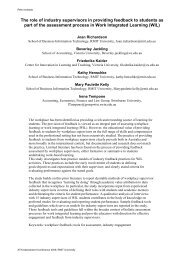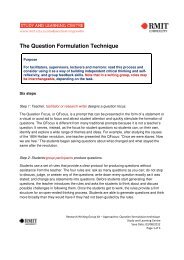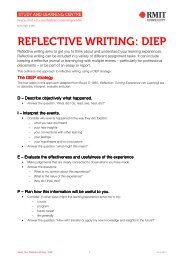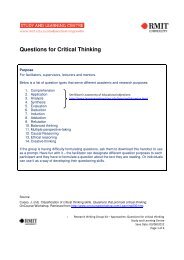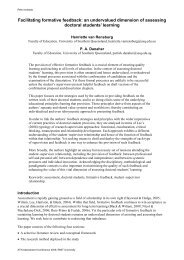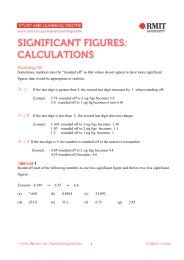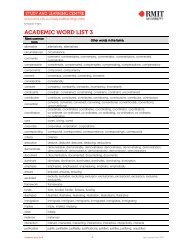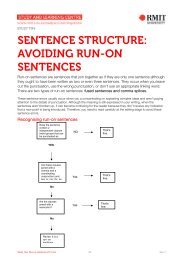student feedback and leadership - Office for Learning and Teaching
student feedback and leadership - Office for Learning and Teaching
student feedback and leadership - Office for Learning and Teaching
You also want an ePaper? Increase the reach of your titles
YUMPU automatically turns print PDFs into web optimized ePapers that Google loves.
Student Feedback & Leadership<br />
This suggests that <strong>for</strong> a multi-level <strong>leadership</strong> approach to <strong>student</strong> <strong>feedback</strong><br />
to be effective, there is need <strong>for</strong> <strong>for</strong>mal leaders to take action that is congruent<br />
with policy decisions in order to develop shared underst<strong>and</strong>ing about policy<br />
<strong>and</strong> its implementation. There is also a need <strong>for</strong> systems <strong>and</strong> infrastructure<br />
to support implementation. For this to occur there is a need <strong>for</strong> DEVOLVED<br />
LEADERSHIP in which power <strong>and</strong> authority to implement policy is given to the<br />
teaching academics. These staff may not hold <strong>for</strong>mal <strong>leadership</strong> positions but,<br />
as they are responsible <strong>for</strong> learning <strong>and</strong> teaching <strong>and</strong> thus <strong>for</strong> <strong>student</strong><br />
<strong>feedback</strong>, they do hold in<strong>for</strong>mal <strong>leadership</strong> roles in <strong>student</strong> <strong>feedback</strong>.<br />
This is illustrated in Figure 9.<br />
Figure 9 Distributed Leadership Model Element One: Devolved Leadership<br />
Shared<br />
Underst<strong>and</strong>ing<br />
DEVOLVED<br />
LEADERSHIP<br />
Congruent Action<br />
Systems & Infrastructure<br />
In applying this model to the experience in Cycle One the following<br />
reflections emerged:<br />
1. The Plenary did provide an opportunity <strong>for</strong> a vertical slice of the University<br />
<strong>leadership</strong> to discuss their role in responding to <strong>student</strong> <strong>feedback</strong>.<br />
Emerging issues <strong>for</strong> <strong>leadership</strong> in <strong>student</strong> <strong>feedback</strong> that were<br />
identified by participants at the Plenary included:<br />
––<br />
the need to adopt a positive approach to <strong>leadership</strong> in the use<br />
of <strong>student</strong> <strong>feedback</strong> rather than a culture of blame on individual<br />
teachers.<br />
––<br />
cultural change <strong>leadership</strong> takes time.<br />
––<br />
the importance of ensuring an equitable balance between financial<br />
returns <strong>and</strong> resources <strong>for</strong> quality learning <strong>and</strong> teaching.<br />
– – the importance of comparing data using a consistent<br />
systems approach.<br />
Page 42



